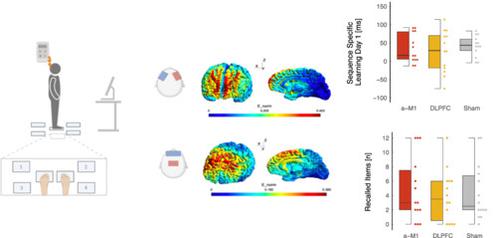当前位置:
X-MOL 学术
›
Eur. J. Nerosci.
›
论文详情
Our official English website, www.x-mol.net, welcomes your feedback! (Note: you will need to create a separate account there.)
Complex sequential learning is not facilitated by transcranial direct current stimulation over DLPFC or M1
European Journal of Neroscience ( IF 3.4 ) Pub Date : 2024-01-25 , DOI: 10.1111/ejn.16255 Elisabeth Kaminski 1, 2 , Daniel Carius 1 , Jan Knieke 1 , Nobuaki Mizuguchi 3, 4 , Patrick Ragert 1, 2
European Journal of Neroscience ( IF 3.4 ) Pub Date : 2024-01-25 , DOI: 10.1111/ejn.16255 Elisabeth Kaminski 1, 2 , Daniel Carius 1 , Jan Knieke 1 , Nobuaki Mizuguchi 3, 4 , Patrick Ragert 1, 2
Affiliation

|
Transcranial direct current stimulation (tDCS) is a non-invasive brain stimulation technique which was found to have a positive modulatory effect on online sequence acquisition or offline motor consolidation, depending on the relative role of the associated brain region. Primary motor regions (M1) and dorsolateral prefrontal cortices (DLPFC) have both been related to sequential learning. However, research so far did not systematically disentangle their differential roles in online and offline learning especially in more complex sequential paradigms. In this study, the influence of anodal M1 leg area-tDCS and anodal DLPFC-tDCS applied during complex sequential learning (online and offline) was investigated using a complex whole body serial reaction time task (CWB-SRTT) in 42 healthy volunteers. TDCS groups did not differ from sham tDCS group regarding their response and reaction time (online) and also not in terms of overnight consolidation (offline). Sequence specific learning and the number of recalled items also did not differ between groups. Results may be related to unspecific parameters such as timing of the stimulation or current intensity but can also be attributed to the relative role of M1 and DLPFC during early complex learning. Taken together, the current study provides preliminary evidence that M1 leg area or DLPFC modulation by means of tDCS does not improve complex sequential skill learning.
中文翻译:

DLPFC 或 M1 上的经颅直流电刺激无法促进复杂的顺序学习
经颅直流电刺激(tDCS)是一种非侵入性脑刺激技术,它被发现对在线序列采集或离线运动巩固具有积极的调节作用,具体取决于相关大脑区域的相对作用。初级运动区(M1)和背外侧前额皮质(DLPFC)都与顺序学习有关。然而,迄今为止的研究尚未系统地理清它们在在线和离线学习中的不同作用,特别是在更复杂的顺序范式中。在本研究中,使用复杂的全身连续反应时间任务 (CWB-SRTT),在 42 名健康志愿者中研究了在复杂顺序学习(在线和离线)过程中应用的阳极 M1 腿部区域-tDCS 和阳极 DLPFC-tDCS 的影响。 TDCS 组在反应和反应时间(在线)方面与假 tDCS 组没有差异,在隔夜巩固(离线)方面也没有差异。序列特异性学习和回忆项目的数量在各组之间也没有差异。结果可能与刺激时间或电流强度等非特定参数有关,但也可归因于 M1 和 DLPFC 在早期复杂学习过程中的相对作用。总而言之,当前的研究提供了初步证据,表明通过 tDCS 进行 M1 腿部区域或 DLPFC 调节并不能改善复杂的顺序技能学习。
更新日期:2024-01-25
中文翻译:

DLPFC 或 M1 上的经颅直流电刺激无法促进复杂的顺序学习
经颅直流电刺激(tDCS)是一种非侵入性脑刺激技术,它被发现对在线序列采集或离线运动巩固具有积极的调节作用,具体取决于相关大脑区域的相对作用。初级运动区(M1)和背外侧前额皮质(DLPFC)都与顺序学习有关。然而,迄今为止的研究尚未系统地理清它们在在线和离线学习中的不同作用,特别是在更复杂的顺序范式中。在本研究中,使用复杂的全身连续反应时间任务 (CWB-SRTT),在 42 名健康志愿者中研究了在复杂顺序学习(在线和离线)过程中应用的阳极 M1 腿部区域-tDCS 和阳极 DLPFC-tDCS 的影响。 TDCS 组在反应和反应时间(在线)方面与假 tDCS 组没有差异,在隔夜巩固(离线)方面也没有差异。序列特异性学习和回忆项目的数量在各组之间也没有差异。结果可能与刺激时间或电流强度等非特定参数有关,但也可归因于 M1 和 DLPFC 在早期复杂学习过程中的相对作用。总而言之,当前的研究提供了初步证据,表明通过 tDCS 进行 M1 腿部区域或 DLPFC 调节并不能改善复杂的顺序技能学习。



























 京公网安备 11010802027423号
京公网安备 11010802027423号